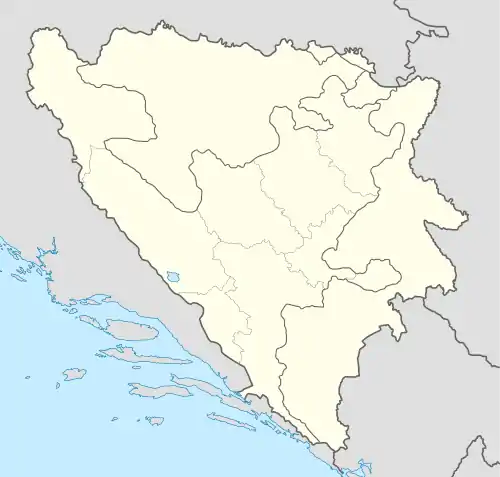Ćavarov Stan | |
|---|---|
Village | |
| Etymology: Ćavar and Croatian: stan ("rearers settlement") | |
 Ćavarov Stan | |
| Coordinates: 43°41′41″N 17°14′29″E / 43.69472°N 17.24139°E | |
| Country | Bosnia and Herzegovina |
| Entity | Federation of Bosnia and Herzegovina |
| Canton | Canton 10 |
| Municipality | Tomislavgrad |
| Population (2013) | |
| • Total | 343 |
| Time zone | UTC+1 (CET) |
| • Summer (DST) | UTC+2 (CEST) |
Ćavarov Stan is a village in the Municipality of Tomislavgrad in Canton 10 of the Federation of Bosnia and Herzegovina, an entity of Bosnia and Herzegovina.
Etymology
Ćavarov is a possessive adjective form of the surname Ćavar, the common surname of the majority of inhabitants of the village. The surname itself is of Venetian origin, meaning a one-year-old ram.[1] Stan in Croatian has multiple meanings, but in the name of the village it refers to a "rearers settlement with huts and sheepfolds during summer pasture".[2]
Geography
Ćavarov Stan is located at the centre of Duvanjsko polje.[1] In the area of Glibina, between Kolo and Ćavarov Stan, there is a hydro-melioration system of canals, on about 800 ha, for drainage of waters in the riverbed of the river Šuica.[3]
History
Transhumance in the 1930s, when the village was founded, was still common in the region of Dinaric Alps, where Ćavarov Stan is located. Most of its inhabitants hale from Kazaginac, a village near the Buško Blato lake, who came to the area of Ćavarov Stan annually during the summer pastures. The majority of the first settlers were surnamed Ćavar, after whom the village was named.[4]
Until the 1953 census, Ćavarov Stan was administratively part of Duvno, the urban centre. However, after the census, it became a separate settlement.[5]
During the period of the socialist Yugoslavia, the village was home to the Review of Agricultural Products and the Review of the Cultural-Artist Work.[6]
Demographics
According to the 2013 census, its population was 343, all Croats.[7]
| Ethnic composition | |||||||
|---|---|---|---|---|---|---|---|
| 2013 | 1991 | 1981 | 1971 | 1961 | |||
| Croats | 343 (100.0%) | 66 (100.0%) | 75 (100.0%) | 74 (100.0%) | 99 (100,0%) | ||
| Total | 343 (100.0%) | 66 (100.0%) | 75 (100.0%) | 74 (100.0%) | 99 (100.0%) | ||
Footnotes
- 1 2 Lukač & Vladić-Mandarić 2020, p. 128.
- ↑ Hrvatski jezični portal.
- ↑ Prostorni plan za područje Hercegbosanske županije za period 2008-2028. godine: nacrt 2014, p. 71.
- ↑ Ivanković 2001, p. 145.
- ↑ Popis stanovništva 1953 1960, p. 363.
- ↑ Lukač & Vladić-Mandarić 2020.
- ↑ Ethnicity/National Affiliation, Religion and Mother Tongue 2019, pp. 528–529.
Bibliography
Books
- Ethnicity/National Affiliation, Religion and Mother Tongue (PDF). Sarajevo: Agency for Statistics of Bosnia and Herzegovina. 2019.
- Ivanković, Ante (2001). Duvanjska prezimena [Surnames of Duvno]. Tomislavgrad-Omiš: Naša Ognjišta-Franjo Kluz. ISBN 9536771209.
- Popis stanovništva 1953. Podaci za naselja prema upravnoj podeli 30.6.1958. Osnovni podaci o stanovništvu [The 1953 population census. The data for settlements according to the administrative division of 30.6.1958. The basic data on population] (in Serbian). Vol. 15. Belgrade: Savezni zavod za statistiku. 1960.
- Prostorni plan za područje Hercegbosanske županije za period 2008-2028. godine: nacrt [Spatial plan for the area of the County of Herzeg-Bosnia for the period of 2008-2028: a draft] (in Croatian). Livno: Vlada Hercegbosanske županije. 2014.
Journals
- Lukač, Zrinka; Vladić-Mandarić, Lidija (2020). "Evaluacija kulturno-umjetničkog amaterizma Tomislavgrada" (PDF). Suvremena pitanja. XV (30): 124–147. Retrieved 14 October 2021.
Websites
- "Stan". Hrvatski jezični portal. Znanje-Srca. Retrieved 14 October 2021.